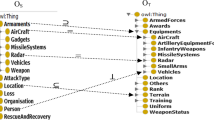Abstract
The amount of Earth Science related domain concepts and vocabularies encoded in popular Semantic Web languages such as OWL and SKOS grows rapidly as more and more domain scientists realize the power of Semantic Web Technologies. The interlinking between these concepts will enable the possibility of performing data integration and identity recognition, which is crucial in developing applications that use data from multiple sources. In this paper, we discuss a new tool for performing concept mapping called SEM+. In SEM+, we designed the Information Entropy based Weighted Similarity Model to compute semantic similarity between entity data and suggest possible linking. We also adopted a blocking approach to group possible matching entities into one block and therefore reduce the computation space. We performed evaluations on SEM+ using the Integrated Ocean Observatory System ontology and the Marine Metadata Interoperability ontology and discussed the results and new findings.

Similar content being viewed by others
Notes
Available at http://mmisw.org/ont/ioos/platform, containing 34 terms.
Available at http://mmisw.org/ont/ioos/parameter, containing 185 terms.
Available at http://mmisw.org/ont/mmi/platform, containing 163 terms.
Available at http://mmisw.org/ont/cf/parameter, containing 2524 terms.
Available at http://mmisw.org/ont/drdc/parameter, containing 41 terms.
References
Baeza-Yates R, Ribeiro-Neto B (1999) Modern information retrieval. ACM Press, Addison-Wesley
Bechhofer S (2009) OWL: web ontology language. Encyclopedia of Database Sytems. Springer US. 2008–2009. Miles, Alistair, and José R. Pérez-Agüera.
Benjelloun O, Garcia-Mollina H, Menestrina D, Su Q, Whang S, Widom J (2009) Swoosh: a generic approach to entity resolution. VLDB J 18(1):255–276
Berners-Lee T, Hendler J, Lassila O (2001) The semantic web. Sci Am 284(5):28–37
Chaudhuri S, Ganti V, Motwani R (2005) Robust identification of fuzzy duplicates. In Prof. of ICDE, pp. 865–876
Cruz IF, Antonelli FP, Stroe C (2009) Agreementmaker: efficient matching for large real-world schemas and ontologies. PVLDB 2(2):1586–1589
Dong X, Halevy Y, Madhavan J (2005) Reference reconciliation in complex information spaces. In Proc. of SIGMOD, pp. 865–876
Duan S, Fokoue A, Srinivas K, Byrne B (2012) A clustering-based approach to ontology alignment, In Proc. of ISWC
Elfeky M, Elmagarmid A, Verykios V (2005) Tailor: a record linkage tool box. In Proc. of SIGMOD, pp. 85–96
Euzenat J (1994) Brief overview of T-Tree: the TROPES taxonomy building tool, in: 4th ASIS SIG/CR Workshop on Classification Research, Columbus (OH, US), pp. 69–87
Haq BU (ed) (2007) The geological time table, 6th edn. Elsevier, Amsterdam
Jean-Mary Y, Shironoshita E, Kabuka M (2009) Ontology matching with semantic verification. In Proc. of Web Semantics: Science, Services and Agents on the World Wide Web
Jimenez-Ruiz E, Grau B (2012) LogMap: logic-based and scalable ontology matching, In Proc. of ISWC
Klyne G, Carroll JJ (2006) Resource description framework (RDF): concepts and abstract syntax
Lin D (1998) An information-theoretic definition of similarity. In Proc. of 15th International Conference of machine Learning (ICML) pp. 296–304
NERC Vocabulary Server, http://vocab.ndg.nerc.ac.uk/
Newcombe H, Kenedy J (1962) Record linkage: making maximum use of the discriminating power of identifying information. Commun ACM 5(11):563–566
Nguyen K, Ichise R, Le B (2012) SLINT: a schema-independent linked data interlinking system. In Ontology Matching (OM 2012)
Raskin RG, Pan MJ (2005) Knowledge representation in the semantic web for earth and environmental terminology (SWEET). Comput Geosci 31(9):1119–1125
Rong S, Niu X, Xiang E, Wang H, Yang Q, Yu Y (2012) A machine learning approach for instance matching based on similarity metrics. In Proc. Of ISWC
Sarawagi S, Bhamidipaty A (2002) Interactive deduplication using active learning. In Proc. of KDD, pp. 269–278
Shannon C (1948) A mathematical theory of communication. Bell Sys Techn J 27(3):379–423
Shvaiko P, Euzenant J (2013) Ontology matching: state of the art and future challenges. IEEE Trans Knowl Data Eng
SKOS (2007) simple knowledge organisation for the web. Cat Classif Q 43.3–4: 69–83.
Stumme G, Madche A (2011) FCA-Merge: bottom-up merging of ontologies, In the 7th International conference on artificial Intellligence (IJCAI), pp. 225–230
Tang J, Li J, Liang B, Huang X, Li Y, Wang K (2006) Using Bayesian decision for ontology mapping. J Web Semantics Sci, Serv Agents World Wide Web, pp. 243–262
Thor A, Rahm E (2007) Moma – a mapping-based object matching system. In Proc. of CIDR, pp. 247–258
Volz J, Bizer C, Gaedke M, Kobilarov G (2009) Discovering and maintaining links on the web of data. In Proc. of ISWC, pp. 650–665
Walker JD, Geissman JW (2009) 2009 GSA geologic time scale. GSA Today 19(4–5):60–61
Yancey W (2002) Bigmatch: a program for extracting probable matches from a large file for record linkage. Statistical research report series rrc2002/01, U.S. Bureau of Census
Author information
Authors and Affiliations
Corresponding author
Additional information
Communicated by: H. A. Babaie
Published in the Special Issue of Semantic e-Science with Guest Editors Dr. Xiaogang Ma, Dr. Peter Fox, Dr. Thomas Narock and Dr. Brian Wilson
Rights and permissions
About this article
Cite this article
Zheng, J.G., Fu, L., Ma, X. et al. SEM+: tool for discovering concept mapping in Earth science related domain. Earth Sci Inform 8, 95–102 (2015). https://doi.org/10.1007/s12145-014-0203-1
Received:
Accepted:
Published:
Issue Date:
DOI: https://doi.org/10.1007/s12145-014-0203-1




